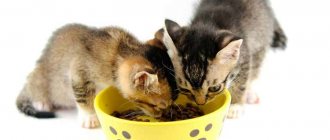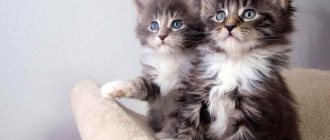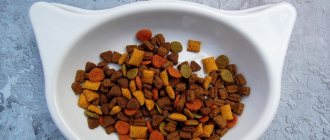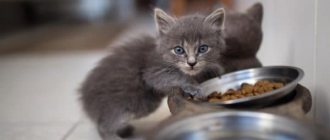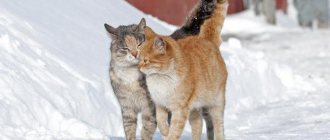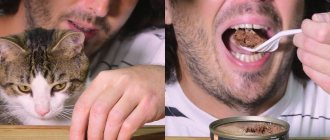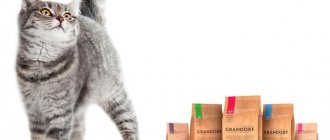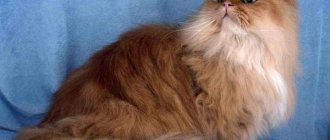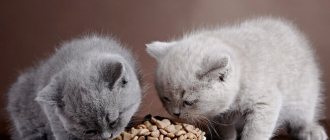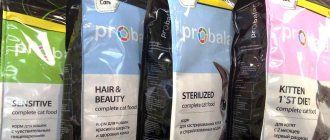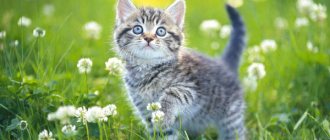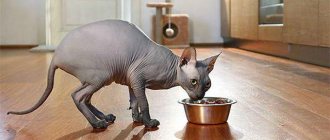Is it possible to give kittens dry food: the advantages of an industrial diet
To understand the safety of feeding dry diets to small cats and kittens, you need to understand their characteristics and composition.
Industrially produced food is specially formulated to meet the nutritional needs of animals, contains all the necessary nutrients for their growth and development and is intended for feeding adult cats and kittens from 3 weeks of age.
The raw materials for production are ordinary products: meat, vegetables, cereals. Vitamins, minerals and many other components are added to the feed to ensure complete nutrition and promote proper growth and a healthy lifestyle for animals.
Dry diets have a number of advantages:
- They are balanced in composition and do not require additional feeding if they meet the parameters of high-quality nutrition.
- They are convenient to dose and can be left on animals for the whole day.
- A very important nuance is that they have a range of diets and the owner does not need to worry about the correct menu for the pet.
- This food is very convenient to take with you if your cat goes on a trip: dry food does not require special storage conditions and does not spoil for a long time.
People have been feeding commercial pet food for over 150 years. During this time, production technologies have advanced significantly - companies use modern innovative technologies designed to preserve maximum nutrients in the feed. Dry food will not harm kittens if you feed the baby correctly.
The combination of dry food and regular food in the diet of kittens
There are three types of pet feeding:
- dry and wet industrial feeds;
- home-cooked food;
- mixed type.
Quite a lot of breeders use the third type of feeding, combining dry food and regular food, and justify this by the fact that manufacturing companies make diets that do not meet the physiological needs of animals. Owners feed their cats alternately dried and natural food, or offer them raw meat as supplementary food.
Some animals are on a mixed type of feeding until they are very old and remain healthy, but still this approach is not entirely safe and can cause health complications due to the functioning of the cat’s digestive system, which produces certain enzymes to break down food groups.
Even the transition from one nutrition system to another sometimes lasts about a month, and in the case of mixed feeding, the body experiences stress and may fail. When contacting a clinic, it will be quite problematic to understand what caused the functional disorder and this will complicate therapy.
Some products in combination with dry food can become a “time bomb”. This primarily applies to fish.
The diet strictly maintains the phosphorus-calcium balance, which is important for cats because they are susceptible to urolithiasis. An additional source of minerals can lead to pathologies of the urinary system.
Dry food and meat
Some cat owners use chicken and other meat products as treats or rewards. Good food does not require additional feeding of animals, and in some cases such actions can harm the pet.
By purchasing super-premium or holistic diets, where the content of meat components is as close as possible to the diet of wild cats, pet owners can be sure that the daily dose is enough to keep the animal full and feeling good.
A few pieces of meat will not harm a cat, but sometimes this leads to a situation where the animal refuses to eat dry food, preferring natural food. Meat is a natural food for most cats; its taste and texture are embedded in the animal’s genetic memory, so convincing your pet that dry kibble is more interesting can sometimes be problematic.
Dry food and milk
A significant portion of kitten owners believe that milk is quite suitable for “washing down” dry food, performing the functions of water. This is a very serious mistake, sometimes leading to the death of the animal.
There are three reasons for this:
- Milk is an additional source of calcium in the diet: the dangers of calcium imbalance were discussed above.
- Cow's milk is not a natural food for cats: in nature it is a natural food for calves. In the diet of cats, milk is used in the most extreme cases (when feeding kittens at an early stage of life in situations where it is not possible to purchase special cat milk substitutes).
- Adding milk to your cat's diet reduces her water intake. Milk is more of a food because of its nutritional value. Dry food requires a lot of water due to its dehydration.
Water is an integral attribute of feeding a cat, a vital component, the restriction of which leads to serious illness and even death of the animal.
Features of nutrition during the transition period
The kitten gets used to food by smell
Any transition to a new product occurs gradually. When introducing the first complementary foods at the age of one month, the kitten should not be denied mother's milk for another month. Each new product is introduced in stages. Complementary feeding begins with dairy products, then egg yolk, poultry or beef, fermented milk products are added, then vegetables. While the kitten is small, all food is served in crushed, wet form.
Diet for feeding
Each product should be introduced gradually into the kitten’s diet. Depending on how old the kitten is, different complementary foods are used.
Use as natural complementary foods:
- milk porridges, without sugar and salt (semolina, buckwheat, rice);
- you can use baby puree mixtures with meat, then add mixtures with vegetables and meat (chicken, turkey, beef);
- when the porridge is digested, you can boil it in water with the addition of yolk, then meat;
- over time, reduce the amount of cereal and increase meat in the diet;
- add to porridge or meat or vegetable stew;
- gradually diversify the diet with fermented milk products such as cottage cheese, cheese, sour cream, kefir.
If the owner intends to accustom the kitten to commercial food, then it is better to start complementary feeding with special dry food for kittens, after soaking it with warm water.
You can pamper kittens, at the same time for their own good, with products such as good quality processed cheese and seafood (shrimp, squid). Also, to strengthen the body, improve the condition of the coat, and the metabolism of the kitten, sprouted oats, which can be soaked at home on the windowsill, are useful.
Water in the diet
Water should always be available for the kitten
Due to immature kidneys, kittens do not have time to concentrate water in the body and quickly lose it, so at the age of 4 weeks, when the kitten begins complementary feeding, there should always be access to fresh, clean water.
- The bowl of water should be at some distance from the bowl of food;
- It is advisable to use a plate made of porcelain or metal;
- do not use plastic containers;
- it is necessary to change the water every day;
- The kitten should always find water easily. You cannot change the location of the bowl, but it is advisable to place several of them in different areas of the apartment.
Lack of fluid or dehydration of an animal can lead to serious consequences.
Principles of combined feeding (dry and wet foods)
Almost all companies produce wet food (pouches and canned food) along with dry food.
Wet food has undeniable advantages:
- They have high taste qualities.
- Make food varied.
- They help increase the water balance in the cat’s body due to its structure (80% consists of water).
- Due to their texture, they are an ideal way for a kitten to transition from mother's milk to dry food, and are also useful for older pets and cats with a number of diseases that preclude the consumption of dry foods.
It is not advisable to give dry and wet food at the same time: it is customary to alternate feeding with different types of industrial diets, preferably of the same brand.
Is it possible to feed a kitten this way?
In some cases, an adult animal can be given two types of food, dividing the intake by time. It is strictly forbidden to feed a kitten with natural food if the baby is accustomed to specialized canned food from birth.
Be sure to read:
The norm of dry food for cats per day, the norm of wet food: how to calculate what affects, how to measure a portion
A gradual transition to natural food is possible from the age of two months.
Feeding kittens with industrial diets from birth to one year
When choosing food for a kitten, it is correct to choose not a brand promoted in the media, but a manufacturing company that produces diets with a high content of animal protein.
Good food:
- 2/3 consists of meat, the indicated sources of which are at the top of the ingredient list.
- Not filled with cheap cereals (wheat, soy).
- Does not have artificial flavors or taste enhancers.
- Consists of specific sources of raw materials.
- Divided into categories, each of which takes into account different protein needs.
Increasingly, cat breeders are giving preference to holistic foods, which are the best way to ensure their pet’s health and longevity. All foods are graded by age, which is what you should take into account when buying food for a kitten.
Training methods and feeding scheme
To help your baby get used to dry food, there are a couple of ways to help him:
- The croquettes are soaked with water or a mother's milk substitute: this paste is given from the finger in small portions. Granules are gradually mixed into it. Sometimes owners soak the food with kefir, but in this case the amount must be reduced with each serving so that the kitten eats only dry food.
- Training begins with wet food, as it is more understandable to the kitten due to its wet texture and meaty smell. After some time, dry granules are added to the canned food until complete replacement.
Scheme for feeding a kitten with dry food from birth to 1 year.
| Age | Number of feedings per day | Diet |
| 3 weeks | 6-8 times | First complementary foods - nutrition from 3 weeks |
| 1–2 months | 6 times | First feeding, spiders and canned food |
| 2–3 months | 5–6 times | Dry food according to the age of the kitten, spiders and canned food |
| 3–4 months | 4–5 times | Dry food according to the age of the kitten |
| 4–5 months | 4 times | Dry food according to the age of the kitten |
| 5–6 months | 3–4 times | Dry food according to the age of the kitten |
| 6–12 months | 2–3 times | Dry food according to the age of the kitten |
On any package of dry or wet food, the daily feeding rate is stated, which is not advisable to exceed. The exception is kittens of large breeds, for which the daily dose of dry food is slightly increased.
